Predictive Analytics: Applications and Impact on Financial Services
VerifiedAdded on 2022/10/17
|5
|2031
|80
Report
AI Summary
This report delves into the application of predictive analytics within the financial services sector. It explores how predictive analytics enables traders and investors to forecast stock prices by analyzing past and present trends. The report highlights customer relationship development as a key aspect, discussing various analytical tools used in business management. It covers the evolution of financial relationship management, emphasizing the importance of data-driven decision-making and customer satisfaction. The paper also touches upon the elimination of customer skepticism through predictive analytics, even with the introduction of new technologies. Furthermore, the report provides a literature review and discusses the methodology, conclusion, limitations, and implications of the research, including areas for future study.
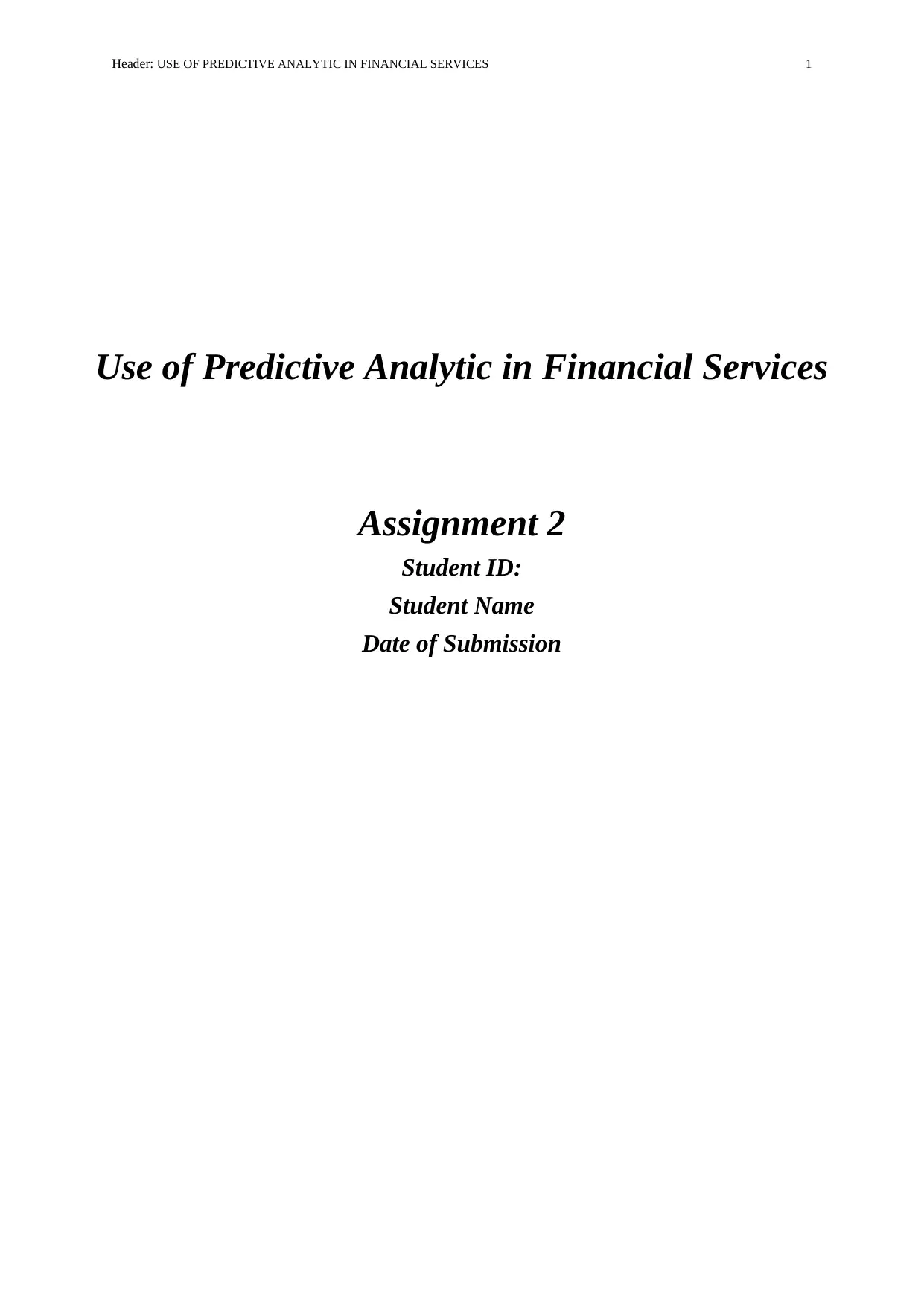
Header: USE OF PREDICTIVE ANALYTIC IN FINANCIAL SERVICES 1
Use of Predictive Analytic in Financial Services
Assignment 2
Student ID:
Student Name
Date of Submission
Use of Predictive Analytic in Financial Services
Assignment 2
Student ID:
Student Name
Date of Submission
Paraphrase This Document
Need a fresh take? Get an instant paraphrase of this document with our AI Paraphraser
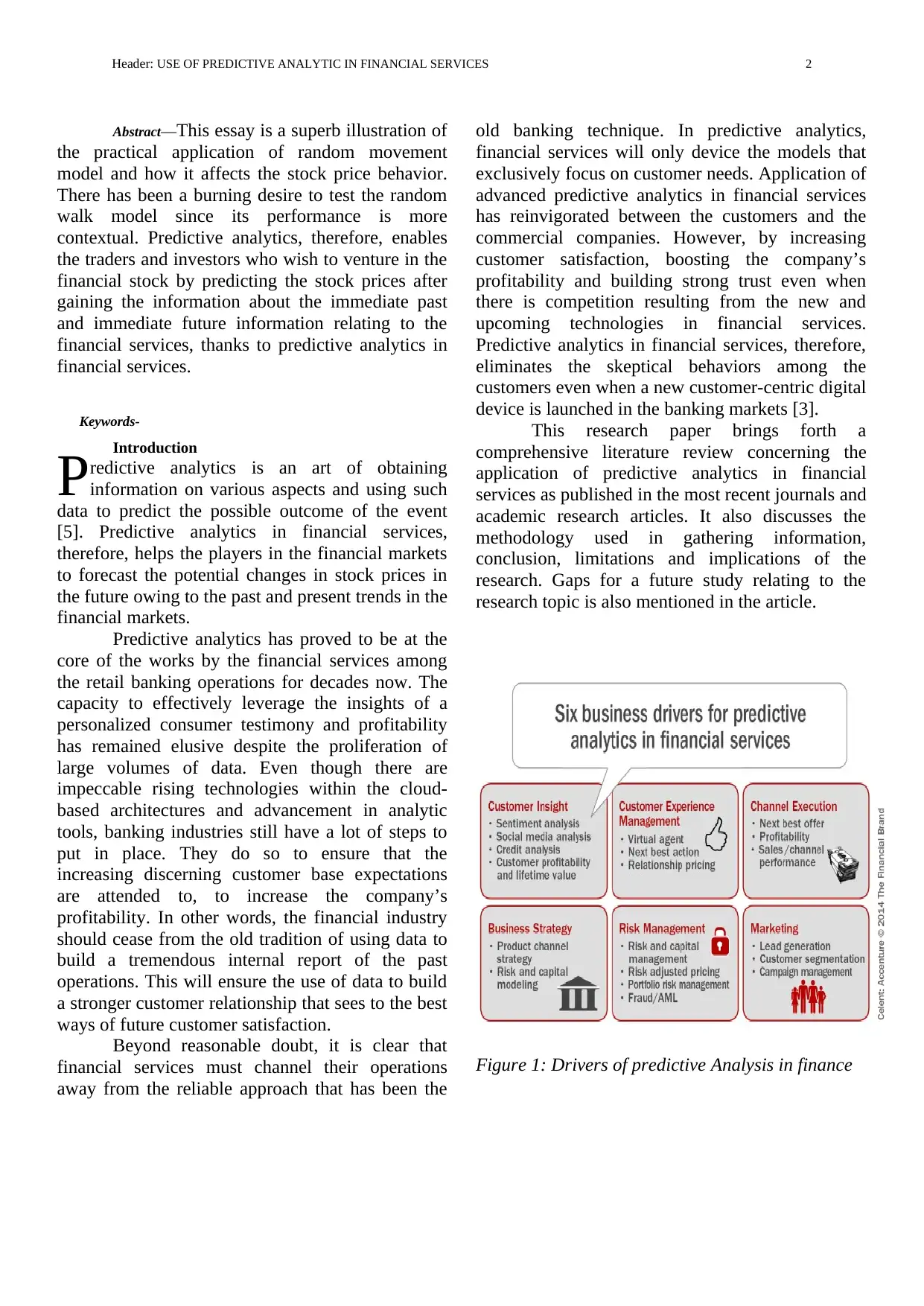
Header: USE OF PREDICTIVE ANALYTIC IN FINANCIAL SERVICES 2
Abstract—This essay is a superb illustration of
the practical application of random movement
model and how it affects the stock price behavior.
There has been a burning desire to test the random
walk model since its performance is more
contextual. Predictive analytics, therefore, enables
the traders and investors who wish to venture in the
financial stock by predicting the stock prices after
gaining the information about the immediate past
and immediate future information relating to the
financial services, thanks to predictive analytics in
financial services.
Keywords-
Introduction
redictive analytics is an art of obtaining
information on various aspects and using such
data to predict the possible outcome of the event
[5]. Predictive analytics in financial services,
therefore, helps the players in the financial markets
to forecast the potential changes in stock prices in
the future owing to the past and present trends in the
financial markets.
P
Predictive analytics has proved to be at the
core of the works by the financial services among
the retail banking operations for decades now. The
capacity to effectively leverage the insights of a
personalized consumer testimony and profitability
has remained elusive despite the proliferation of
large volumes of data. Even though there are
impeccable rising technologies within the cloud-
based architectures and advancement in analytic
tools, banking industries still have a lot of steps to
put in place. They do so to ensure that the
increasing discerning customer base expectations
are attended to, to increase the company’s
profitability. In other words, the financial industry
should cease from the old tradition of using data to
build a tremendous internal report of the past
operations. This will ensure the use of data to build
a stronger customer relationship that sees to the best
ways of future customer satisfaction.
Beyond reasonable doubt, it is clear that
financial services must channel their operations
away from the reliable approach that has been the
old banking technique. In predictive analytics,
financial services will only device the models that
exclusively focus on customer needs. Application of
advanced predictive analytics in financial services
has reinvigorated between the customers and the
commercial companies. However, by increasing
customer satisfaction, boosting the company’s
profitability and building strong trust even when
there is competition resulting from the new and
upcoming technologies in financial services.
Predictive analytics in financial services, therefore,
eliminates the skeptical behaviors among the
customers even when a new customer-centric digital
device is launched in the banking markets [3].
This research paper brings forth a
comprehensive literature review concerning the
application of predictive analytics in financial
services as published in the most recent journals and
academic research articles. It also discusses the
methodology used in gathering information,
conclusion, limitations and implications of the
research. Gaps for a future study relating to the
research topic is also mentioned in the article.
Figure 1: Drivers of predictive Analysis in finance
Abstract—This essay is a superb illustration of
the practical application of random movement
model and how it affects the stock price behavior.
There has been a burning desire to test the random
walk model since its performance is more
contextual. Predictive analytics, therefore, enables
the traders and investors who wish to venture in the
financial stock by predicting the stock prices after
gaining the information about the immediate past
and immediate future information relating to the
financial services, thanks to predictive analytics in
financial services.
Keywords-
Introduction
redictive analytics is an art of obtaining
information on various aspects and using such
data to predict the possible outcome of the event
[5]. Predictive analytics in financial services,
therefore, helps the players in the financial markets
to forecast the potential changes in stock prices in
the future owing to the past and present trends in the
financial markets.
P
Predictive analytics has proved to be at the
core of the works by the financial services among
the retail banking operations for decades now. The
capacity to effectively leverage the insights of a
personalized consumer testimony and profitability
has remained elusive despite the proliferation of
large volumes of data. Even though there are
impeccable rising technologies within the cloud-
based architectures and advancement in analytic
tools, banking industries still have a lot of steps to
put in place. They do so to ensure that the
increasing discerning customer base expectations
are attended to, to increase the company’s
profitability. In other words, the financial industry
should cease from the old tradition of using data to
build a tremendous internal report of the past
operations. This will ensure the use of data to build
a stronger customer relationship that sees to the best
ways of future customer satisfaction.
Beyond reasonable doubt, it is clear that
financial services must channel their operations
away from the reliable approach that has been the
old banking technique. In predictive analytics,
financial services will only device the models that
exclusively focus on customer needs. Application of
advanced predictive analytics in financial services
has reinvigorated between the customers and the
commercial companies. However, by increasing
customer satisfaction, boosting the company’s
profitability and building strong trust even when
there is competition resulting from the new and
upcoming technologies in financial services.
Predictive analytics in financial services, therefore,
eliminates the skeptical behaviors among the
customers even when a new customer-centric digital
device is launched in the banking markets [3].
This research paper brings forth a
comprehensive literature review concerning the
application of predictive analytics in financial
services as published in the most recent journals and
academic research articles. It also discusses the
methodology used in gathering information,
conclusion, limitations and implications of the
research. Gaps for a future study relating to the
research topic is also mentioned in the article.
Figure 1: Drivers of predictive Analysis in finance
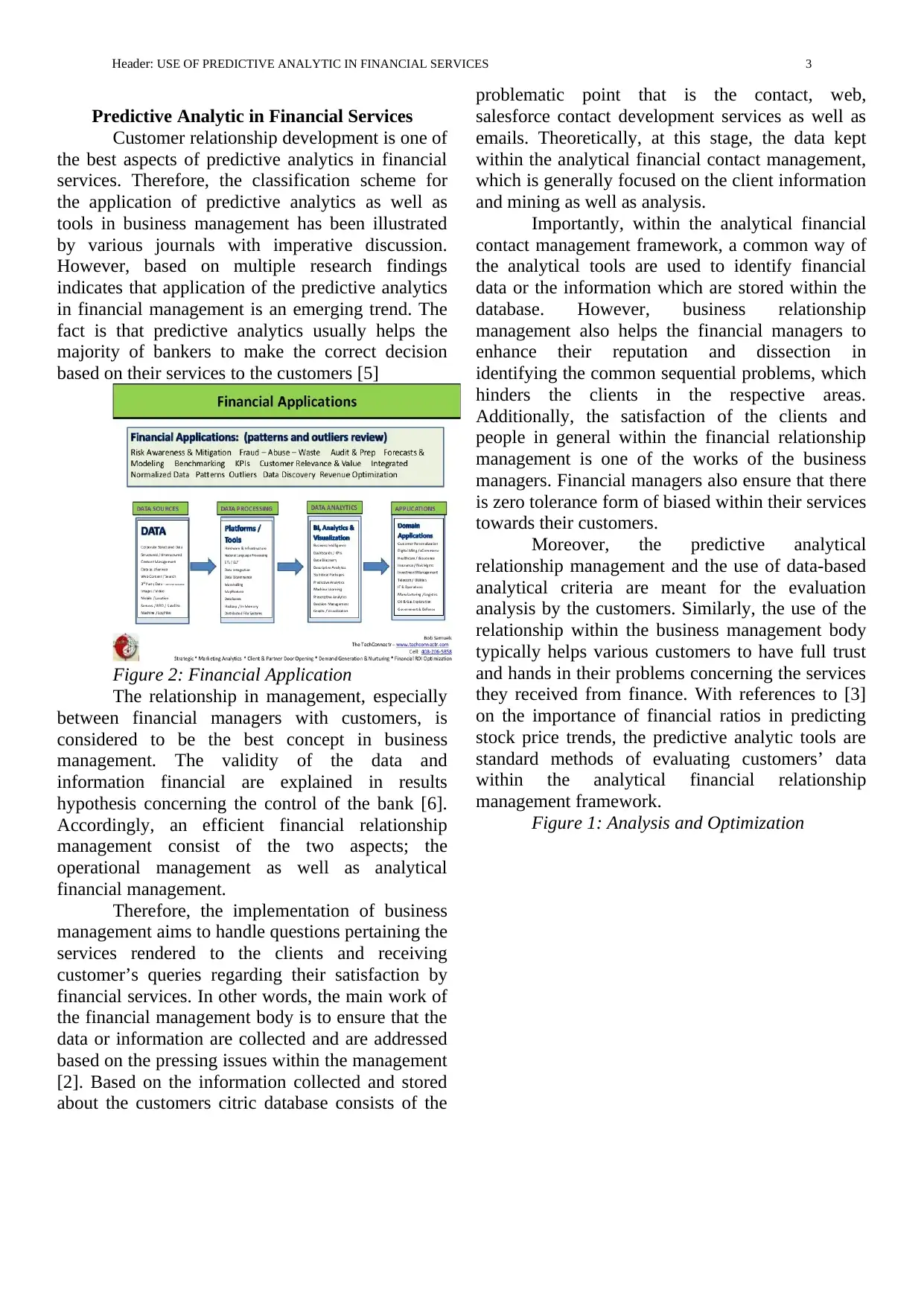
Header: USE OF PREDICTIVE ANALYTIC IN FINANCIAL SERVICES 3
Predictive Analytic in Financial Services
Customer relationship development is one of
the best aspects of predictive analytics in financial
services. Therefore, the classification scheme for
the application of predictive analytics as well as
tools in business management has been illustrated
by various journals with imperative discussion.
However, based on multiple research findings
indicates that application of the predictive analytics
in financial management is an emerging trend. The
fact is that predictive analytics usually helps the
majority of bankers to make the correct decision
based on their services to the customers [5]
Figure 2: Financial Application
The relationship in management, especially
between financial managers with customers, is
considered to be the best concept in business
management. The validity of the data and
information financial are explained in results
hypothesis concerning the control of the bank [6].
Accordingly, an efficient financial relationship
management consist of the two aspects; the
operational management as well as analytical
financial management.
Therefore, the implementation of business
management aims to handle questions pertaining the
services rendered to the clients and receiving
customer’s queries regarding their satisfaction by
financial services. In other words, the main work of
the financial management body is to ensure that the
data or information are collected and are addressed
based on the pressing issues within the management
[2]. Based on the information collected and stored
about the customers citric database consists of the
problematic point that is the contact, web,
salesforce contact development services as well as
emails. Theoretically, at this stage, the data kept
within the analytical financial contact management,
which is generally focused on the client information
and mining as well as analysis.
Importantly, within the analytical financial
contact management framework, a common way of
the analytical tools are used to identify financial
data or the information which are stored within the
database. However, business relationship
management also helps the financial managers to
enhance their reputation and dissection in
identifying the common sequential problems, which
hinders the clients in the respective areas.
Additionally, the satisfaction of the clients and
people in general within the financial relationship
management is one of the works of the business
managers. Financial managers also ensure that there
is zero tolerance form of biased within their services
towards their customers.
Moreover, the predictive analytical
relationship management and the use of data-based
analytical criteria are meant for the evaluation
analysis by the customers. Similarly, the use of the
relationship within the business management body
typically helps various customers to have full trust
and hands in their problems concerning the services
they received from finance. With references to [3]
on the importance of financial ratios in predicting
stock price trends, the predictive analytic tools are
standard methods of evaluating customers’ data
within the analytical financial relationship
management framework.
Figure 1: Analysis and Optimization
Predictive Analytic in Financial Services
Customer relationship development is one of
the best aspects of predictive analytics in financial
services. Therefore, the classification scheme for
the application of predictive analytics as well as
tools in business management has been illustrated
by various journals with imperative discussion.
However, based on multiple research findings
indicates that application of the predictive analytics
in financial management is an emerging trend. The
fact is that predictive analytics usually helps the
majority of bankers to make the correct decision
based on their services to the customers [5]
Figure 2: Financial Application
The relationship in management, especially
between financial managers with customers, is
considered to be the best concept in business
management. The validity of the data and
information financial are explained in results
hypothesis concerning the control of the bank [6].
Accordingly, an efficient financial relationship
management consist of the two aspects; the
operational management as well as analytical
financial management.
Therefore, the implementation of business
management aims to handle questions pertaining the
services rendered to the clients and receiving
customer’s queries regarding their satisfaction by
financial services. In other words, the main work of
the financial management body is to ensure that the
data or information are collected and are addressed
based on the pressing issues within the management
[2]. Based on the information collected and stored
about the customers citric database consists of the
problematic point that is the contact, web,
salesforce contact development services as well as
emails. Theoretically, at this stage, the data kept
within the analytical financial contact management,
which is generally focused on the client information
and mining as well as analysis.
Importantly, within the analytical financial
contact management framework, a common way of
the analytical tools are used to identify financial
data or the information which are stored within the
database. However, business relationship
management also helps the financial managers to
enhance their reputation and dissection in
identifying the common sequential problems, which
hinders the clients in the respective areas.
Additionally, the satisfaction of the clients and
people in general within the financial relationship
management is one of the works of the business
managers. Financial managers also ensure that there
is zero tolerance form of biased within their services
towards their customers.
Moreover, the predictive analytical
relationship management and the use of data-based
analytical criteria are meant for the evaluation
analysis by the customers. Similarly, the use of the
relationship within the business management body
typically helps various customers to have full trust
and hands in their problems concerning the services
they received from finance. With references to [3]
on the importance of financial ratios in predicting
stock price trends, the predictive analytic tools are
standard methods of evaluating customers’ data
within the analytical financial relationship
management framework.
Figure 1: Analysis and Optimization
⊘ This is a preview!⊘
Do you want full access?
Subscribe today to unlock all pages.

Trusted by 1+ million students worldwide
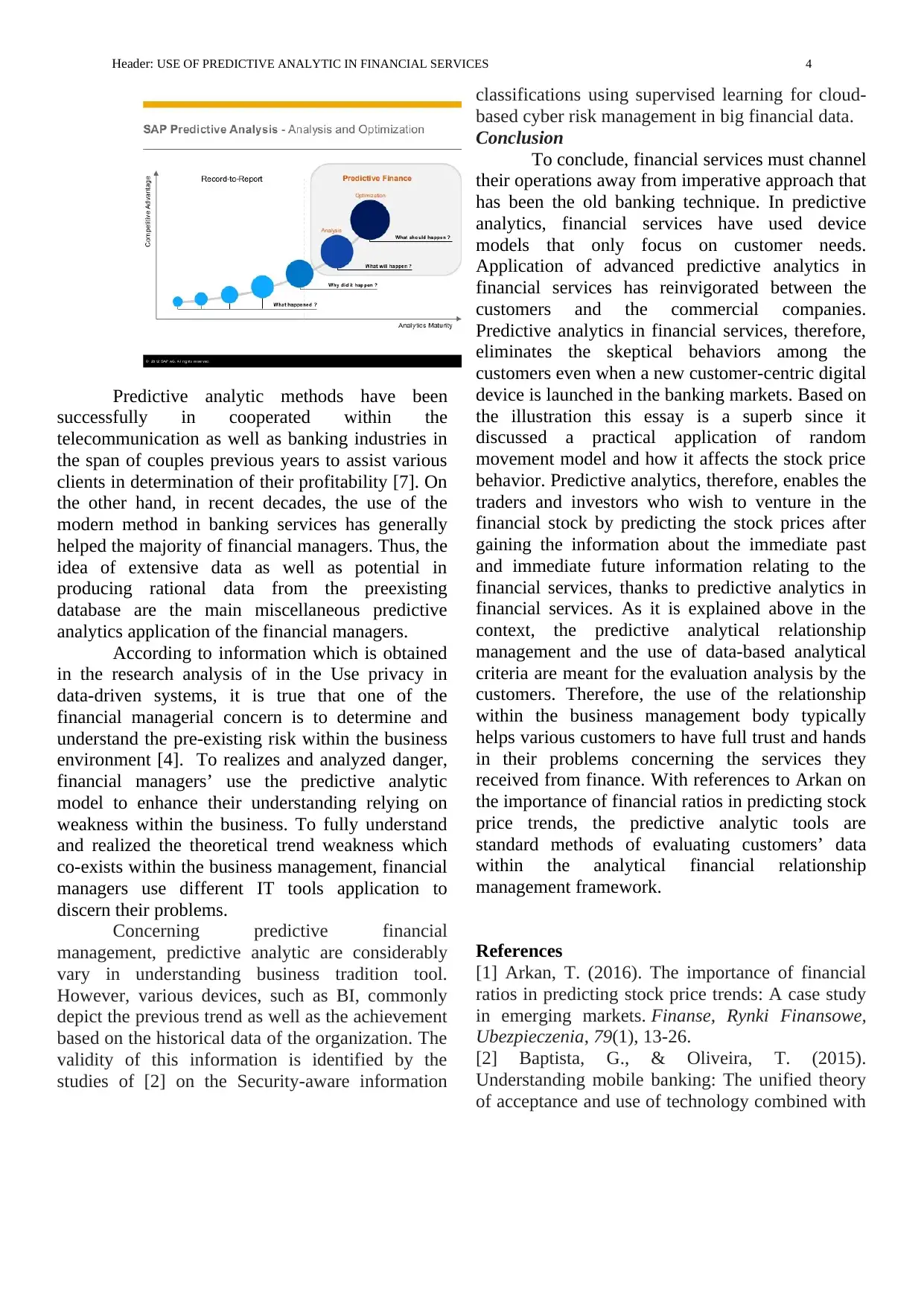
Header: USE OF PREDICTIVE ANALYTIC IN FINANCIAL SERVICES 4
Predictive analytic methods have been
successfully in cooperated within the
telecommunication as well as banking industries in
the span of couples previous years to assist various
clients in determination of their profitability [7]. On
the other hand, in recent decades, the use of the
modern method in banking services has generally
helped the majority of financial managers. Thus, the
idea of extensive data as well as potential in
producing rational data from the preexisting
database are the main miscellaneous predictive
analytics application of the financial managers.
According to information which is obtained
in the research analysis of in the Use privacy in
data-driven systems, it is true that one of the
financial managerial concern is to determine and
understand the pre-existing risk within the business
environment [4]. To realizes and analyzed danger,
financial managers’ use the predictive analytic
model to enhance their understanding relying on
weakness within the business. To fully understand
and realized the theoretical trend weakness which
co-exists within the business management, financial
managers use different IT tools application to
discern their problems.
Concerning predictive financial
management, predictive analytic are considerably
vary in understanding business tradition tool.
However, various devices, such as BI, commonly
depict the previous trend as well as the achievement
based on the historical data of the organization. The
validity of this information is identified by the
studies of [2] on the Security-aware information
classifications using supervised learning for cloud-
based cyber risk management in big financial data.
Conclusion
To conclude, financial services must channel
their operations away from imperative approach that
has been the old banking technique. In predictive
analytics, financial services have used device
models that only focus on customer needs.
Application of advanced predictive analytics in
financial services has reinvigorated between the
customers and the commercial companies.
Predictive analytics in financial services, therefore,
eliminates the skeptical behaviors among the
customers even when a new customer-centric digital
device is launched in the banking markets. Based on
the illustration this essay is a superb since it
discussed a practical application of random
movement model and how it affects the stock price
behavior. Predictive analytics, therefore, enables the
traders and investors who wish to venture in the
financial stock by predicting the stock prices after
gaining the information about the immediate past
and immediate future information relating to the
financial services, thanks to predictive analytics in
financial services. As it is explained above in the
context, the predictive analytical relationship
management and the use of data-based analytical
criteria are meant for the evaluation analysis by the
customers. Therefore, the use of the relationship
within the business management body typically
helps various customers to have full trust and hands
in their problems concerning the services they
received from finance. With references to Arkan on
the importance of financial ratios in predicting stock
price trends, the predictive analytic tools are
standard methods of evaluating customers’ data
within the analytical financial relationship
management framework.
References
[1] Arkan, T. (2016). The importance of financial
ratios in predicting stock price trends: A case study
in emerging markets. Finanse, Rynki Finansowe,
Ubezpieczenia, 79(1), 13-26.
[2] Baptista, G., & Oliveira, T. (2015).
Understanding mobile banking: The unified theory
of acceptance and use of technology combined with
Predictive analytic methods have been
successfully in cooperated within the
telecommunication as well as banking industries in
the span of couples previous years to assist various
clients in determination of their profitability [7]. On
the other hand, in recent decades, the use of the
modern method in banking services has generally
helped the majority of financial managers. Thus, the
idea of extensive data as well as potential in
producing rational data from the preexisting
database are the main miscellaneous predictive
analytics application of the financial managers.
According to information which is obtained
in the research analysis of in the Use privacy in
data-driven systems, it is true that one of the
financial managerial concern is to determine and
understand the pre-existing risk within the business
environment [4]. To realizes and analyzed danger,
financial managers’ use the predictive analytic
model to enhance their understanding relying on
weakness within the business. To fully understand
and realized the theoretical trend weakness which
co-exists within the business management, financial
managers use different IT tools application to
discern their problems.
Concerning predictive financial
management, predictive analytic are considerably
vary in understanding business tradition tool.
However, various devices, such as BI, commonly
depict the previous trend as well as the achievement
based on the historical data of the organization. The
validity of this information is identified by the
studies of [2] on the Security-aware information
classifications using supervised learning for cloud-
based cyber risk management in big financial data.
Conclusion
To conclude, financial services must channel
their operations away from imperative approach that
has been the old banking technique. In predictive
analytics, financial services have used device
models that only focus on customer needs.
Application of advanced predictive analytics in
financial services has reinvigorated between the
customers and the commercial companies.
Predictive analytics in financial services, therefore,
eliminates the skeptical behaviors among the
customers even when a new customer-centric digital
device is launched in the banking markets. Based on
the illustration this essay is a superb since it
discussed a practical application of random
movement model and how it affects the stock price
behavior. Predictive analytics, therefore, enables the
traders and investors who wish to venture in the
financial stock by predicting the stock prices after
gaining the information about the immediate past
and immediate future information relating to the
financial services, thanks to predictive analytics in
financial services. As it is explained above in the
context, the predictive analytical relationship
management and the use of data-based analytical
criteria are meant for the evaluation analysis by the
customers. Therefore, the use of the relationship
within the business management body typically
helps various customers to have full trust and hands
in their problems concerning the services they
received from finance. With references to Arkan on
the importance of financial ratios in predicting stock
price trends, the predictive analytic tools are
standard methods of evaluating customers’ data
within the analytical financial relationship
management framework.
References
[1] Arkan, T. (2016). The importance of financial
ratios in predicting stock price trends: A case study
in emerging markets. Finanse, Rynki Finansowe,
Ubezpieczenia, 79(1), 13-26.
[2] Baptista, G., & Oliveira, T. (2015).
Understanding mobile banking: The unified theory
of acceptance and use of technology combined with
Paraphrase This Document
Need a fresh take? Get an instant paraphrase of this document with our AI Paraphraser
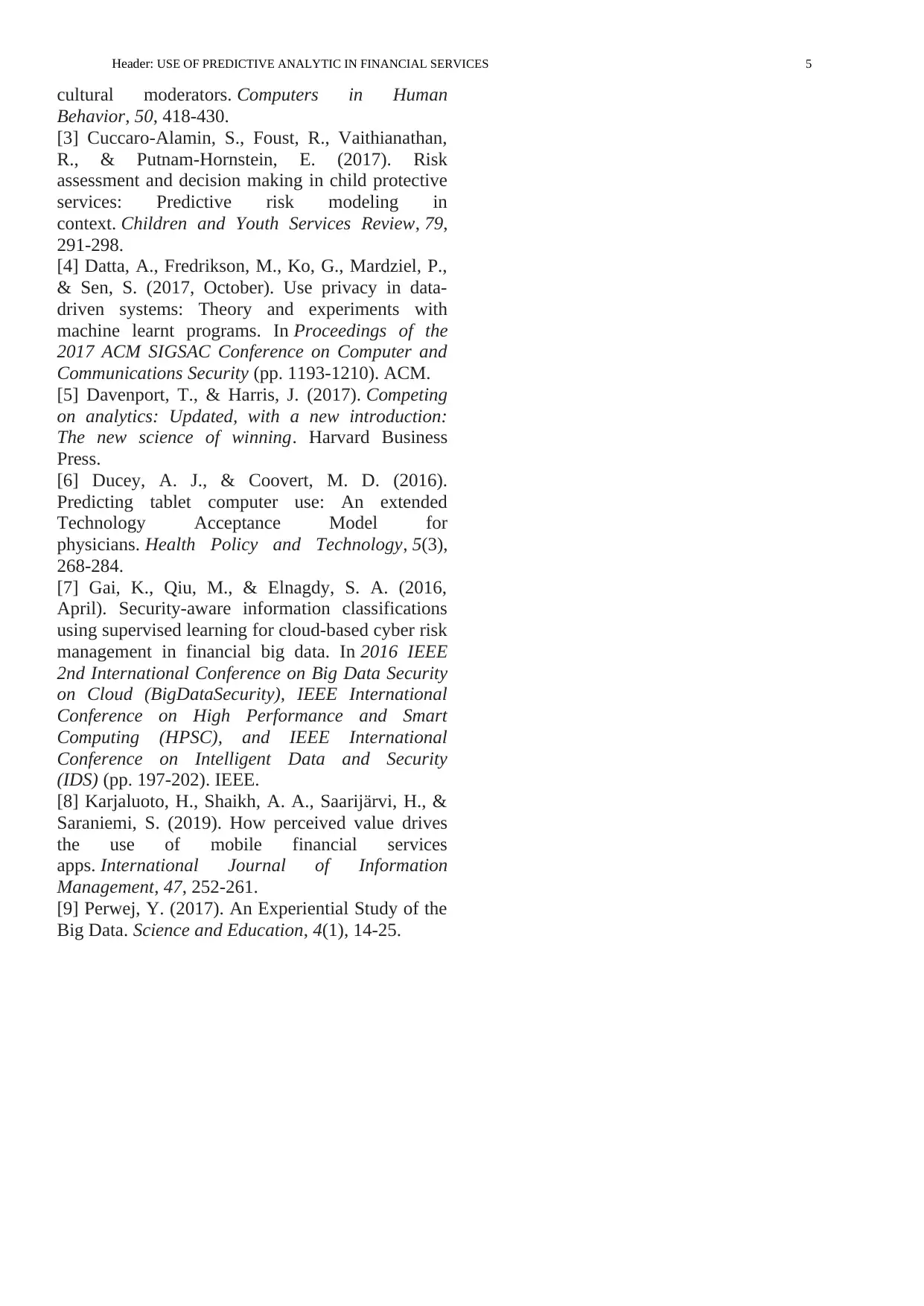
Header: USE OF PREDICTIVE ANALYTIC IN FINANCIAL SERVICES 5
cultural moderators. Computers in Human
Behavior, 50, 418-430.
[3] Cuccaro-Alamin, S., Foust, R., Vaithianathan,
R., & Putnam-Hornstein, E. (2017). Risk
assessment and decision making in child protective
services: Predictive risk modeling in
context. Children and Youth Services Review, 79,
291-298.
[4] Datta, A., Fredrikson, M., Ko, G., Mardziel, P.,
& Sen, S. (2017, October). Use privacy in data-
driven systems: Theory and experiments with
machine learnt programs. In Proceedings of the
2017 ACM SIGSAC Conference on Computer and
Communications Security (pp. 1193-1210). ACM.
[5] Davenport, T., & Harris, J. (2017). Competing
on analytics: Updated, with a new introduction:
The new science of winning. Harvard Business
Press.
[6] Ducey, A. J., & Coovert, M. D. (2016).
Predicting tablet computer use: An extended
Technology Acceptance Model for
physicians. Health Policy and Technology, 5(3),
268-284.
[7] Gai, K., Qiu, M., & Elnagdy, S. A. (2016,
April). Security-aware information classifications
using supervised learning for cloud-based cyber risk
management in financial big data. In 2016 IEEE
2nd International Conference on Big Data Security
on Cloud (BigDataSecurity), IEEE International
Conference on High Performance and Smart
Computing (HPSC), and IEEE International
Conference on Intelligent Data and Security
(IDS) (pp. 197-202). IEEE.
[8] Karjaluoto, H., Shaikh, A. A., Saarijärvi, H., &
Saraniemi, S. (2019). How perceived value drives
the use of mobile financial services
apps. International Journal of Information
Management, 47, 252-261.
[9] Perwej, Y. (2017). An Experiential Study of the
Big Data. Science and Education, 4(1), 14-25.
cultural moderators. Computers in Human
Behavior, 50, 418-430.
[3] Cuccaro-Alamin, S., Foust, R., Vaithianathan,
R., & Putnam-Hornstein, E. (2017). Risk
assessment and decision making in child protective
services: Predictive risk modeling in
context. Children and Youth Services Review, 79,
291-298.
[4] Datta, A., Fredrikson, M., Ko, G., Mardziel, P.,
& Sen, S. (2017, October). Use privacy in data-
driven systems: Theory and experiments with
machine learnt programs. In Proceedings of the
2017 ACM SIGSAC Conference on Computer and
Communications Security (pp. 1193-1210). ACM.
[5] Davenport, T., & Harris, J. (2017). Competing
on analytics: Updated, with a new introduction:
The new science of winning. Harvard Business
Press.
[6] Ducey, A. J., & Coovert, M. D. (2016).
Predicting tablet computer use: An extended
Technology Acceptance Model for
physicians. Health Policy and Technology, 5(3),
268-284.
[7] Gai, K., Qiu, M., & Elnagdy, S. A. (2016,
April). Security-aware information classifications
using supervised learning for cloud-based cyber risk
management in financial big data. In 2016 IEEE
2nd International Conference on Big Data Security
on Cloud (BigDataSecurity), IEEE International
Conference on High Performance and Smart
Computing (HPSC), and IEEE International
Conference on Intelligent Data and Security
(IDS) (pp. 197-202). IEEE.
[8] Karjaluoto, H., Shaikh, A. A., Saarijärvi, H., &
Saraniemi, S. (2019). How perceived value drives
the use of mobile financial services
apps. International Journal of Information
Management, 47, 252-261.
[9] Perwej, Y. (2017). An Experiential Study of the
Big Data. Science and Education, 4(1), 14-25.
1 out of 5
Related Documents
Your All-in-One AI-Powered Toolkit for Academic Success.
+13062052269
info@desklib.com
Available 24*7 on WhatsApp / Email
![[object Object]](/_next/static/media/star-bottom.7253800d.svg)
Unlock your academic potential
Copyright © 2020–2025 A2Z Services. All Rights Reserved. Developed and managed by ZUCOL.





